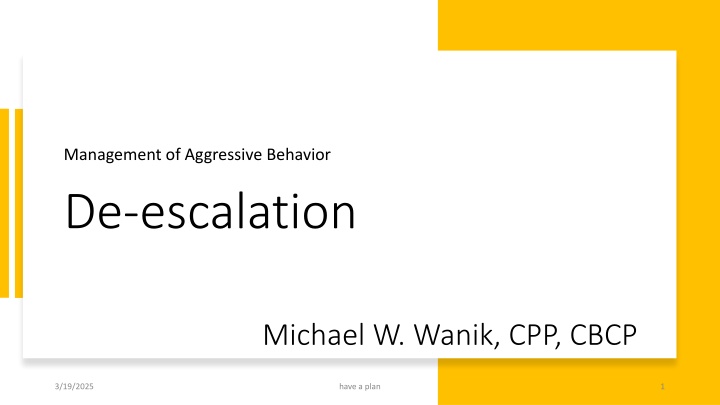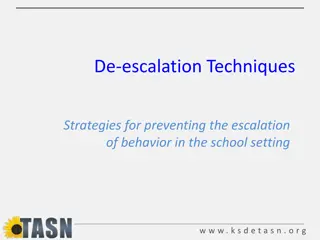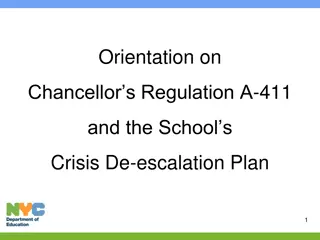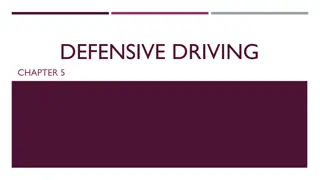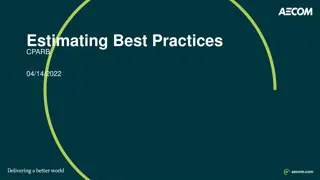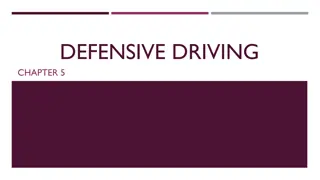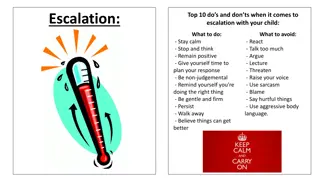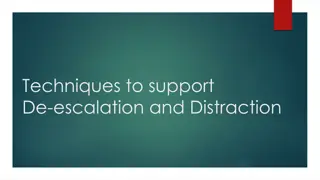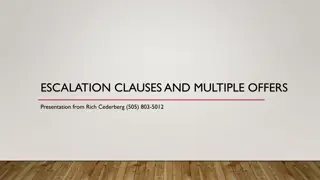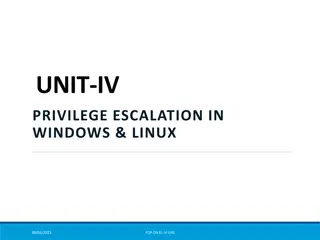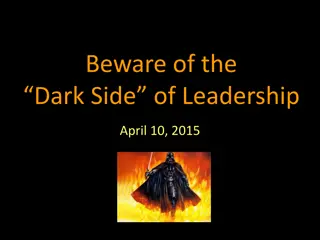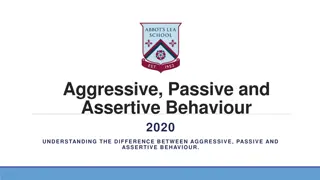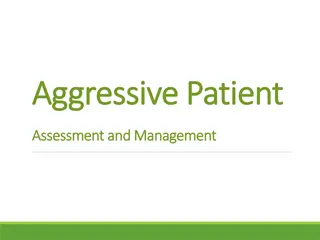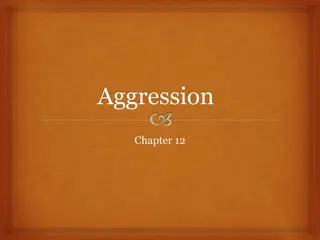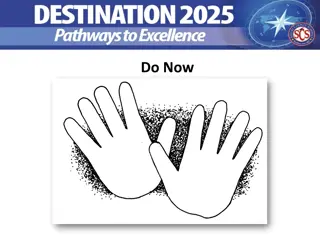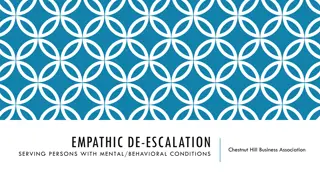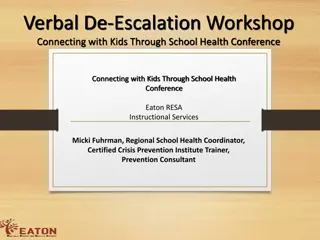Management of Aggressive Behavior De-escalation Techniques
This session familiarizes attendees with techniques for managing individuals experiencing anxiety and escalating situations, applicable to healthcare and law enforcement professionals. The stages of escalation, mental and physical awareness, and strategies for de-escalation are covered. Practical advice on maintaining space, utilizing non-verbal communication, and managing aggressors' anxiety is provided.
Download Presentation

Please find below an Image/Link to download the presentation.
The content on the website is provided AS IS for your information and personal use only. It may not be sold, licensed, or shared on other websites without obtaining consent from the author.If you encounter any issues during the download, it is possible that the publisher has removed the file from their server.
You are allowed to download the files provided on this website for personal or commercial use, subject to the condition that they are used lawfully. All files are the property of their respective owners.
The content on the website is provided AS IS for your information and personal use only. It may not be sold, licensed, or shared on other websites without obtaining consent from the author.
E N D
Presentation Transcript
Management of Aggressive Behavior De-escalation Michael W. Wanik, CPP, CBCP 3/19/2025 have a plan 1
Todays World Is Full of Many Emotional Issues Mask/No Mask Voting Methodologies Race Relations With Many Opinions Blue/Red Why Yes/No At Many Intensity Levels of Concern Reasonable/ Aggressive Soft/ Loud Displaying Visible Symbols and Messaging 3/19/2025 have a plan 2
This short session familiarizes attendees with techniques utilized by healthcare and law enforcement professionals while dealing with an individual who is experiencing anxiety and are escalating in a situation. The techniques are not fool-proof nor complete. You should always disconnect from an uncomfortable situation and obtain additional help as deemed necessary. Disclaimer 3/19/2025 have a plan 3
Escalation Stages 3/19/2025 have a plan 4
Mentally Physically Awareness Preparation Early Plan Safety/Control in Numbers Continuum of Influence Presence Voice Demeanor Body Language Messaging Directives 3/19/2025 have a plan 5
3/19/2025 have a plan 6
It is recommended that at the upset (anxiety) stage, we maintain a minimum space of 4 feet. Reaction Time At the verbally aggressive stage, we maintain a minimum space of 6 feet. 3/19/2025 have a plan 7
55% of communication is non-verbal 38% is inflection, pitch and volume Only 7% of the message is the spoken word 3/19/2025 have a plan 8
Managing the Aggressor's Anxiety Proper space Supportive eye communications Supportive gestures and postures Supportive facial expressions Father Murphy Stance Bladed body Supportive hands Ready to Exit the Zone 3/19/2025 9 have a plan
Managing the Aggressor's Anxiety Empathic listening Supportive verbal communications Supportive stance 3/19/2025 have a plan 10
Five Levels of Listening Ignoring another person Pretending to listen Selective listening Attentive listening Empathic listening 3/19/2025 have a plan 11
If It Escalates, Its About Ego Low Self Esteem Must Feel Superior to Others and In Control You may not like me, but you re gonna respect me Defuse by building self esteem Remove the audience Move away from the audience Utilize formal and informal leaders 3/19/2025 have a plan 12
Supportive Verbal Communications Skills Maintain a calm reassuring voice Communicate at their level Speak with respect Be in control Kinesiology- the study of body movements 3/19/2025 have a plan 13
Resistance breeds persistence Supportive Verbal Communications Skills Volume of speech Use paralanguage Tone of voice Rate of speed Avoid using "You" 3/19/2025 have a plan 14
Ask Ask them to repeat (clarify) Supportive Verbal Communications Skills Ask Ask open ended questions Clarify implied statements, threats, or key words Clarify 3/19/2025 have a plan 15
Isolate Isolate the problem from the individual Supportive Verbal Communications Skills Redirect Redirect anger to the past Interrupt by If appropriate, interrupt by using their name 3/19/2025 have a plan 16
Leadership Axiom- Unless you meet people where they are, no progress will be made. Asserting:When you know what you want, have a clear outcome identified and articulate your preferences clearly. You challenge others input, ideas, or questions, because you are just that clear. How we can influence: Negotiating: The ability to compromise and make concessions to reach consensus and common ground. Rationalizing:Using facts, figures, logic and reason, as opposed to emotion or gut instinct. Bridging:Intentionally building relationships and connecting with others in your organization. Often demonstrated in leaders who engage in meaningful exchanges that reflect active listening, thoughtful questions and authentic concern for others. Inspiring: The ability to influence by creating a sense of shared purpose, accountability and possibility. 3/19/2025 have a plan 17
Auditory Exclusion The thousand-yard stare- They are lost in thought and possibly planning something 3/19/2025 have a plan 18
Legs Signals To Watch For And Understand Stance Leaning the body Weight shift 3/19/2025 have a plan 19
A body language technique Diversions- Used to interrupt the aggressor s focus or intent. A positive verbal command Throwing or dropping an object Moving as an escape technique 3/19/2025 have a plan 20
Office Dealings have a plan 3/19/2025 21
Recap Respect personal space Don t be provocative Establish verbal contact, no touching Be concise Identify wants and feelings Listen Closely Agree or agree to disagree Give direction Offer optimism Always have a plan Questions? have a plan- luck favors the prepared! 3/19/2025 22
Thank You. Michael W. Wanik, CPP, CBCP mwanik@hotmail.com (860) 463-3532 3/19/2025 have a plan 23
